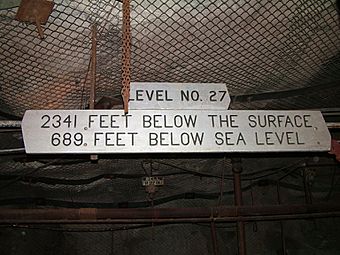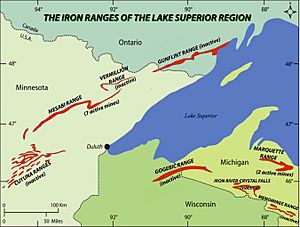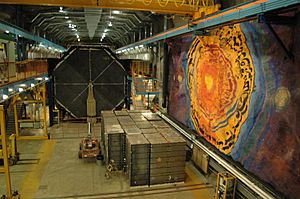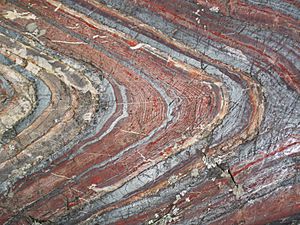Soudan Underground Mine State Park facts for kids
|
Soudan Iron Mine
|
|

The 27th level of the Soudan Mine
|
|
| Location | Tower-Soudan State Park, Breitung Township, St. Louis County, Minnesota |
|---|---|
| Nearest city | Tower, Minnesota |
| Area | 122 hectares (301 acres) |
| Built | 1900 |
| Website | Lake Vermilion-Soudan Underground Mine State Park |
| NRHP reference No. | 66000905 |
Quick facts for kids Significant dates |
|
| Added to NRHP | November 13, 1966 |
| Designated NHL | November 13, 1966 |
The Soudan Underground Mine State Park is a cool place in Minnesota. It's built around the old Soudan Underground Mine, which is on the south side of Lake Vermilion. This mine is famous for being Minnesota's oldest, deepest, and richest mine for iron. Today, it's also home to the Soudan Underground Laboratory. Because of its history, the Soudan Iron Mine is a special place called a U.S. National Historic Landmark.
Contents
History of the Soudan Mine
In the late 1800s, people were looking for gold in northern Minnesota. Instead, they found something even better: super rich iron ore! This ore, called hematite, had more than 65% iron. Mining started in 1882 with an open pit, which means digging from the surface.
By 1900, they moved to underground mining. This was safer for the workers. From 1901 until 1962, the mine was owned by the United States Steel Corporation. By 1912, the mine was already 1,250 feet (381 meters) deep.
When the mine closed, it was incredibly deep. The lowest part, called level 27, was 2,341 feet (713.5 meters) below the surface. All the tunnels underground stretched for more than fifty miles! In 1965, the mine was given to the State of Minnesota. This was so it could be used for learning and education.
How They Mined Iron at Soudan
The main way they mined here was called "cut and fill." Imagine mining the ceiling of a tunnel. As they dug out the iron ore, they would fill the space below with waste rock. This rock came from the mine itself, like Ely Greenstone.
This way, the floor and ceiling always stayed about 10–20 feet (3–6 meters) apart. They didn't need to bring the waste rock all the way to the surface. They just moved it a short distance and left it inside the mine. This method worked well at Soudan because the iron ore was very strong. The rock around it, called Greenstone, was weaker. This method wasn't possible in other nearby mines because their iron formations were not as stable.
Soudan Underground Mine State Park
The park is located in Breitung Township, Minnesota, right on the shore of Lake Vermilion. This area is part of northern Minnesota's Vermilion Range (Minnesota). It's a popular spot for tourists. Many people visit it on their way to or from Ely and the Boundary Waters Canoe Area Wilderness.
The Minnesota Department of Natural Resources runs the state park. The mine is also a National Historic Landmark. This means it's a very important historical site. You can visit the buildings on the surface. During the summer, you can even take tours deep into the mine!
Visitors ride an 80-year-old electric mine hoist down to level 27. This is the lowest part of the mine, 2,341 feet (713.5 meters) underground. There are two main tours. One shows you the old mining equipment and how they worked. The other tour focuses on the science lab that's still active underground.
Underground Laboratory at Soudan
In the 1980s, scientists from the University of Minnesota started using the Soudan Mine. It's a great place for sensitive physics experiments. This is because very few cosmic rays can reach so deep underground. This makes it a quiet place for experiments.
The mine first hosted the Soudan 1 experiment, which looked for proton decay. Then came Soudan 2, which ran from 1989 to 2001. Since then, the University and the Minnesota Department of Natural Resources have made the lab bigger. Now it holds other important physics projects.
These projects include the MINOS neutrino detector. Scientists also search for dark matter with experiments like CDMS-II, SuperCDMS, and CoGeNT. They even work on making super pure copper using a process called electroforming. This copper is used in experiments because it has no radiation.
The Soudan Mine was considered for a big U.S. Deep Underground Science and Engineering Laboratory. However, that project was later given to the Homestake Mine (South Dakota). Parts of the lab are open for daily tours. There's also an annual open house where you can see more and talk to the scientists.
2011 Fire at Soudan Mine
A fire started late on March 17, 2011. It was in the main shaft, on the 25th level of the mine. Firefighters put out the fire using 70,000 gallons of foam. A lot of cleanup was needed at the bottom of the shaft (level 27). It filled up with thick foam from floor to ceiling.
The Underground Laboratory lost power, but it stayed safe. The underground mine tours were closed for the summer of 2011. However, the tours above ground and the visitor center reopened. The underground tours started again on May 26, 2012.







